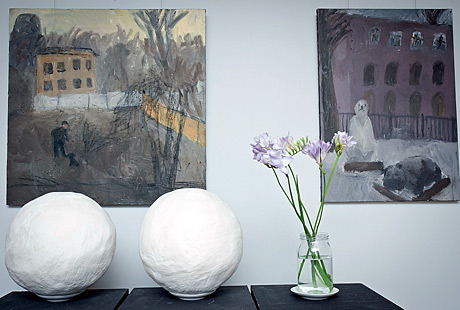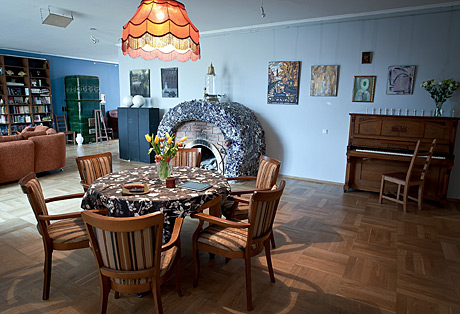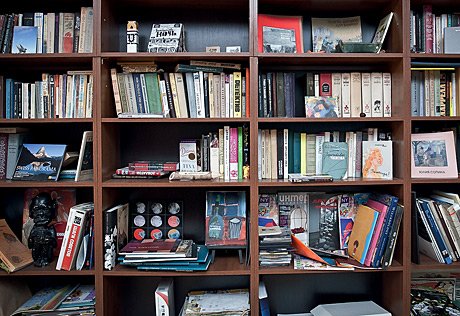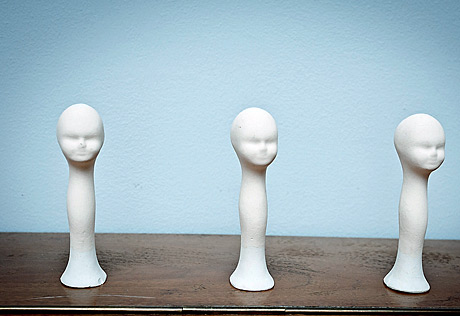The apartment of artist and gallerist Anna Frants and her husband Leonid, a collector and financier, located on the top floor of the “Dovlatov House”, serves as an exhibition space, a creative laboratory, and a place where contemporary art is born and discussed.
In 1912, architect Alexey Baryshnikov built this income house for a merchant society on Rubinstein Street, designing a deep cour d’honneur — a grand courtyard with an ornate fence and lanterns. At various times, the building was home to journalist John Reed, ballerina Natalia Dudinskaya, and writer Sergei Dovlatov.
Anna and Leonid had to change almost everything in the apartment: it was previously a large communal flat for three families, with tiny cubicle-like rooms. Their goal was to create a space that could function as both a home and a gallery. So, in addition to a bedroom and study, they needed a large living room that could accommodate many people. When there are no special exhibitions, the walls feature works from their collection of St. Petersburg artists from the second half of the 20th century: “grandfather” of the Mitki group Vladimir Yashke, the “hopeless painter” Boris Borshch, and members of the Sterligov group, such as Elizaveta Alexandrova and Valentina Povarova, who taught Anna color theory at the Mukhina School. The collection is curated by Leonid, while Anna works on her own projects — exhibition pieces recently returned from a show in Switzerland rest against the walls.
In one of Dovlatov’s stories, he writes about sitting by a green stove. Such stoves exist in every apartment in the building. The Frants couple put in significant effort to preserve theirs, even though previous tenants had carved out a niche in it to store books.
Anna and Leonid dismantled the stove and reassembled it in another part of the apartment, lowering it because matching green ceramic tiles to patch the hole proved impossible to find. They cleaned the chimney and built a fireplace in its former place, decorating it with shards of Lomonosov porcelain cups. Anna got this idea after a trip to Barcelona, to Park Güell, created by the famous visionary Antoni Gaudí, who tiled benches and sculptures with colorful ceramic fragments.
Cabinet of Curiosities
Nearly every object in the Frants home is a piece from an exhibition or an artwork by a renowned master. The “white tiger skin” sprawled on the wall was made using an old technique for crafting Christmas ornaments — from cotton wool and papier-mâché. Anna received a toy like this as a gift from Tatiana Ponomarenko, director of the Borey Gallery. The technique fascinated Anna, and she tracked down the artisan and purchased the “skin” from her.
The photographs in the living room are part of the project “Residue” from Anna’s solo exhibition in Zurich. A flask with blue liquid made from Curaçao liqueur was created by artist Mikhail Krest specifically for the opening party of the Cyberfest media art festival, organized by Anna. The Soviet-era soda vending machines — from the 1960s — were intentionally sourced for a memory-themed project. The glass spheres on the dresser are components of an upcoming installation, still in preparation. A vase in the shape of an amphora was featured in the Hermitage Museum as part of the multimedia installation “Made in Ancient Greece.” Even the skirt Anna wears is hand-painted by artist Marina Koldobskaya.
Time Regained
The main feature of this interior is its changeability. The wall colors shift from deep blue to pure white, and the furniture constantly moves. The owners treat things with affection — they are drawn to eclecticism, much like collage art, where entirely different objects form a harmonious whole. However, they try not to get too attached:
“Too much sentimentality toward Soviet-era objects killed Moscow conceptualism — all the tenderness drained away.”
That said, the couple regularly visits flea markets like Udelka. That’s where they found the lampshade above the round table in the living room, as well as metal glass holders for their growing collection. Anna’s former classmate and now assistant, Varvara Egorova, helps find unique pieces. Old Singer sewing machines were repurposed as computer desks. Chairs from a casino furniture sale were reupholstered and assembled into a matching set.
Step by step, this became an art project in the form of an apartment on Rubinstein Street.








